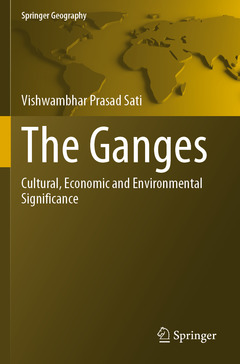Description
The Ganges, 1st ed. 2021
Cultural, Economic and Environmental Significance
Springer Geography Series
Author: Sati Vishwambhar Prasad
Language: English
Subjects for The Ganges:
Keywords
The Ganges; Ganges River; Ganges culture; Ganges economic; Ganges geography
Publication date: 08-2022
164 p. · 15.5x23.5 cm · Paperback
Publication date: 08-2021
164 p. · 15.5x23.5 cm · Hardback
Description
/li>Contents
/li>Biography
/li>Comment
/li>
?The Ganges: Cultural, Economic, and Environmental Importance? is a geographical, cultural, economic, and environmental interpretation of the Ganga River. The Ganga River originates from Gaumukh- situated in the high Himalaya, flows through the world?s biggest fertile alluvial plain, and inlets into the Bay of Bengal at Ganga Sagar. It makes a unique natural and cultural landscape and is believed to be the holiest river of India. The Hindus called it ?Mother Ganga? and worship it. The towns/cities, situated on its bank, are world-famous and are known as the highland and valley pilgrimages. The water of the Ganga is pious, and the Hindus use it on different occasions while performing the rituals and customs. This book is unique because no previous study which presents a complete and comprehensive geographical description of the Ganga has been composed. This book presents the historical and cultural significance of the Ganga and its tributaries. Empirical, archival, and observation methods were applied to conduct this study. There are a total of 10 chapters in this book such as ?Introduction?, ?the Ganga Basin?, ?Geography of the Ganga Basin?, ?the Ganges System: Ganga and its Tributaries?, ?Ganga between Gaumukh and Uttarkashi?, ?the Major Cultural Towns?, ?Major Fairs and Festivals?, ?Economic Significance of the Ganga?, ?Environmental Issues?, and ?Conclusions?. The contents of the book are enriched by 89 figures, 15 tables, and substantial citations and references.
List of Figures
Glossary and Abbreviation
Chapter 1: Introduction
Abstract
1.1 Origin and Extension of the Ganga River
1.2 Historical Perspectives of the Ganga
1.3 Cultural and Economic Importance of the Ganga
1.4 Importance of Water in Hindu Scriptures
1.5 Description of the Ganga in Hindus Religious Wisdom
1.6 Objectives and Significance of the Study
1.7 Organization of the Study
References
Chapter 2: The Ganga Basin
Abstract
2.1 Introduction
2.2 Salient Features of the Ganga and its Tributaries
2.3 State-Wise Distribution of Drainage Area
2.4 Area, Population, and Density of the Ganga Basin
2.5 Conclusions
References
Chapter 3: Geography of the Ganga Basin
Abstract
3.1 Introduction
3.2 Climate
3.3 Faunal Resources
3.4 Floral Resources
3.5 Ganga’s Topography
3.5.1 The First Stage (Youthful)3.5.2 The Second Stage (Mature)
3.5.3 Third Stage (Old Stage)
3.6 Conclusions
References
Chapter 4: The Ganga and its Tributaries
Abstract
4.1 Introduction
4.2 The Ganga River
4.3 The Yamuna River
4.4 Tons River
4.5 The Bhilangana River
4.6 The Alaknanda River
4.7 The Saraswati River
4.8 The Dhauli Ganga
4.9 The Nandakini River
4.10 The Pindar River
4.11 The Mandakini River4.12 Kali Ganga
4.13 Son Ganga
4.14 Madhyamaheshwar Ganga
4.15 The Nayar River (E)
4.16 The Nayar River (W)
4.17 Ramganga (W)
4.18 The Kosi River
4.19 The Kali River
4.20 The Dhauli Ganga (E)
4.21 The Goriganga
4.22 The Ramganga (E)
4.23 The Saryu River
4.24 The Gomati River
4.25 Conclusions
References
Chapter 5: The Ganga between Gaumukh and Uttarkashi
Abstract
5.1 Introduction
5.2 A Journey from Uttarkashi to Gangotri
5.3 Case Study of Some Important Villages
5.3.1 Gaumukh
5.3.2 Gangotri
5.3.3 Bhaironghati
5.3.4 Lanka
5.3.5 Mukhimath (Mukhawa)
5.3.6 Dharali
5.3.7 Harshil
5.3.8 Jaspur5.3.9 Sukhi
5.3.10 Gangnani
5.3.11 Bhatwadi
5.3.12 Uttarkashi5.4 Conclusion
References
Chapter 6: The Major Cultural Towns
Abstract
6.1 Introduction
6.2 Major Cultural Towns Situated on the Bank of the Ganga
6.2.1 Gaumukh
6.2.2 Gangotri
6.2.3 Uttarkashi
6.2.4 Devprayag
6.2.5 Rishikesh
6.2.6 Haridwar
6.2.7 Prayagraj
6.2.8 Varanasi
6.2.9 Gangasagar
6.3 Other Major Cultural Towns Situated on the Tributaries of the Ganga
6.3.1 Kedarnath
6.3.2 Badrinath
6.3.3 The Main Prayags
6.3.4 Yamunotri
6.3.5 Hanol
6.3.6 Bageshwar
6.3.7 Jageshwar
6.4 Some Important Tirthas on the Bank of the Ganga
6.5 Conclusions
References
Chapter 7: Major Fairs and Festivals
Abstract
7.1 Introduction
7.2 Important Fairs and Festivals
7.2.1 Magh Mela
7.2.2 Kumbh Mela
7.2.3 Baishakhi
7.2.4 Akshaya Tritiya
7.2.5 Ganga Dashami/Dussehra
7.2.6 Kanwar Yatra
7.2.7 Ganga Mahotsav
7.3 Conclusions
Chapter 8: Economic Significance of the Ganga
Abstract
8.1 Introduction8.2 Ganga: The Life Line of India
8.3 The Agro-climatic Zones and Agricultural Development
8.4 Hydroelectricity Power Potential
8.5 ConclusionsReferences
Chapter 9: Environmental Issues in the Ganga Basin
Abstract
9.1 Introduction
9.2 Construction of Hydropower Projects
9.3 Increasing Pollution in the Ganga
9.4 Pollution in Ganga Water and its Impact
9.5 Conservation of the Ganga River
9.6 Conclusions
References
Chapter 10: Conclusions
10.1 Cultural Importance of the Ganga10.2 Natural and Economic Importance
10.3 Issues of Environmental Degradation
Presents a unique empirical and archival data-based study on The Ganges
Highlights The Ganges economic, cultural, and environmental importance
Is useful resource to the scholars, researchers, academicians, and students interested in fluvial and integrated geography




